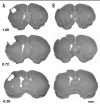Variation in chronic nicotinamide treatment after traumatic brain injury can alter components of functional recovery independent of histological damage
- PMID: 19794908
- PMCID: PMC2715190
- DOI: 10.4161/oxim.1.1.6694
Variation in chronic nicotinamide treatment after traumatic brain injury can alter components of functional recovery independent of histological damage
Abstract
Previously, we have shown that the window of opportunity for nicotinamide (NAM) therapy (50 mg/kg) following cortical contusion injuries (CCI) extended to 4-8 hrs post-CCI when administered over a six day post-CCI interval. The purpose of the present study was to determine if a more chronic NAM treatment protocol administered following CCI would extend the current window of opportunity for effective treatment onset. Groups of rats received either unilateral CCI's or sham procedures. Initiation of NAM therapy (50 mg/kg, ip) began at either 15-min, 4-hrs, 8-hrs or 24-hrs post-injury. All groups received daily systemic treatments for 12 days post-CCI at 24 hr intervals. Behavioral assessments were conducted for 28 days post injury and included: vibrissae forelimb placing, bilateral tactile adhesive removal, forelimb asymmetry task and locomotor placing testing. Behavioral analysis on both the tactile removal and locomotor placing tests showed that all NAM-treated groups facilitated recovery of function compared to saline treatment. However, on the vibrissae-forelimb placing and forelimb asymmetry tests only the 4-hr and 8-hr NAM-treated groups were significantly different from the saline-treated group. The lesion analysis showed that treatment with NAM out to 8 hrs post-CCI significantly reduced the size of the injury cavity. The window of opportunity for NAM treatment is task-dependent and in some situations can extend to 24 hrs post-CCI. These results suggest that a long term treatment regimen of 50 mg/kg of NAM starting at the clinically relevant time points may prove efficacious in human TBI.
Keywords: recovery of function; therapy; traumatic brain injury; vitamin; window of opportunity.
Figures






References
-
- Narayan RK, Michel ME, Ansell B, Baethmann A, Biegon A, Bracken MB, Bullock MR, Choi SC, Clifton GL, Contant CF, Coplin WM, Dietrich WD, Ghajar J, Grady SM, Grossman RG, Hall ED, Heetderks W, Hovda DA, Jallo J, Katz RL, Knoller N, Kochanek PM, Maas AI, Majde J, Marion DW, Marmarou A, Marshall LF, McIntosh TK, Miller E, Mohberg N, Muizelaar JP, Pitts LH, Quinn P, Riesenfeld G, Robertson CS, Strauss KI, Teasdale G, Temkin N, Tuma R, Wade C, Walker MD, Weinrich M, Whyte J, Wilberger J, Young AB, Yurkewicz L. Clinical trials in head injury. J Neurotrauma. 2002;19:503–557. - PMC - PubMed
-
- Thurman DJ, Alverson CA, Dunn KA, Guerrero J, Sniezek JE. Traumatic brain injury in the United States: a public health perspective. J Head Trauma Rehabil. 1999;14:602–615. - PubMed
-
- Thurman DJ, Guerrero J. Trends in hospitalization associated with traumatic brain injury. JAMA. 1999;282:954–957. - PubMed
-
- Sahuquillo J, Poca MA, Amoros S. Current aspects of pathophysiology and cell dysfunction after severe head injury. Curr Pharm Des. 2001;7:1475–1503. - PubMed
Publication types
MeSH terms
Substances
Grants and funding
LinkOut - more resources
Full Text Sources

